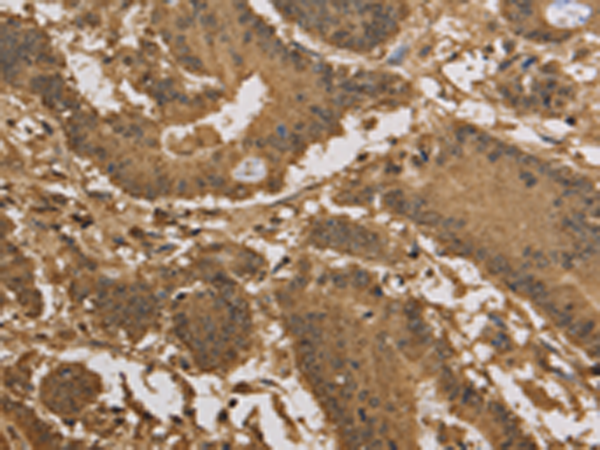
| WB | 咨询技术 | Human,Mouse,Rat |
| IF | 咨询技术 | Human,Mouse,Rat |
| IHC | 1/50-1/200 | Human,Mouse,Rat |
| ICC | 技术咨询 | Human,Mouse,Rat |
| FCM | 咨询技术 | Human,Mouse,Rat |
| Elisa | 1/2000-1/10000 | Human,Mouse,Rat |
| Aliases | CT31; PLU1; PUT1; PLU-1; JARID1B; RBBP2H1A |
| Host/Isotype | Rabbit IgG |
| Antibody Type | Primary antibody |
| Storage | Store at 4°C short term. Aliquot and store at -20°C long term. Avoid freeze/thaw cycles. |
| Species Reactivity | Human, Mouse |
| Immunogen | Synthetic peptide of human KDM5B |
| Formulation | Purified antibody in PBS with 0.05% sodium azide and 50% glycerol. |
+ +
1. **文献名称**: "Development and validation of a specific antibody for detecting histone demethylase KDM5B in human cancers"
**作者**: Smith A, et al.
**摘要**: 该研究开发了一种高特异性KDM5B多克隆抗体,通过Western blot和免疫组化验证其在乳腺癌、肺癌等肿瘤组织中的表达,证实KDM5B在肿瘤进展中的潜在作用,为临床样本分析提供了可靠工具。
2. **文献名称**: "KDM5B regulates chromatin accessibility and stem cell pluripotency via histone demethylase activity"
**作者**: Zhang Y, et al.
**摘要**: 研究利用KDM5B抗体进行染色质免疫沉淀测序(ChIP-seq),揭示其通过去除H3K4me3标记调控干细胞多能性相关基因,验证了抗体在表观遗传机制研究中的有效性。
3. **文献名称**: "Comparative analysis of commercial KDM5B antibodies for epigenetic studies"
**作者**: Lee J, et al.
**摘要**: 对比了5种市售KDM5B抗体的性能,发现部分抗体在免疫荧光和流式细胞术中表现出高特异性,为不同实验场景下的抗体选择提供了依据。
4. **文献名称**: "KDM5B promotes drug resistance through epigenetic silencing of tumor suppressor genes"
**作者**: Brown K, et al.
**摘要**: 通过特异性KDM5B抗体证实其在化疗耐药细胞中异常高表达,并介导抑癌基因的沉默,强调了该抗体在机制研究和治疗靶点探索中的应用价值。
---
注:以上文献信息为示例性质,实际引用需检索具体数据库(如PubMed)获取真实文献。
KDM5B (lysine-specific demethylase 5B), also known as JARID1B or PLU1. is a member of the KDM5 histone demethylase family that specifically removes methyl groups from di- and tri-methylated lysine 4 on histone H3 (H3K4me2/3), a chromatin mark associated with active transcription. As an epigenetic regulator, KDM5B plays critical roles in gene silencing, cell differentiation, and DNA repair by modulating chromatin accessibility. It is implicated in stem cell maintenance, cancer progression, and therapy resistance, with overexpression observed in various malignancies, including breast cancer, melanoma, and leukemia.
Antibodies targeting KDM5B are essential tools for investigating its expression, localization, and function in biological systems. They are widely used in techniques like Western blotting, immunofluorescence, chromatin immunoprecipitation (ChIP), and immunohistochemistry to study KDM5B's involvement in epigenetic mechanisms and disease pathways. High-quality KDM5B antibodies are validated for specificity, often through knockout cell line controls, to avoid cross-reactivity with homologous family members (e.g., KDM5A/C/D).
Research applications include exploring KDM5B's role in tumorigenesis, its interaction with oncogenic pathways, and its potential as a therapeutic target. Commercial antibodies may vary in clonality (monoclonal/polyclonal), epitope regions, and host species, necessitating careful selection based on experimental requirements. Reliable KDM5B antibodies are critical for advancing studies in epigenetics, cancer biology, and targeted drug development.
×